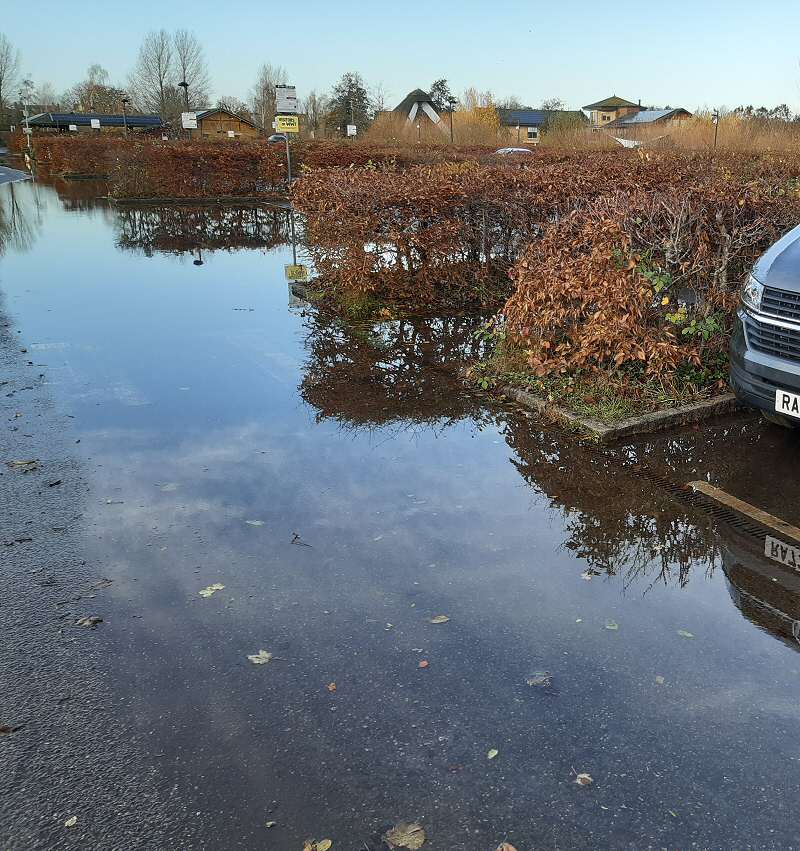
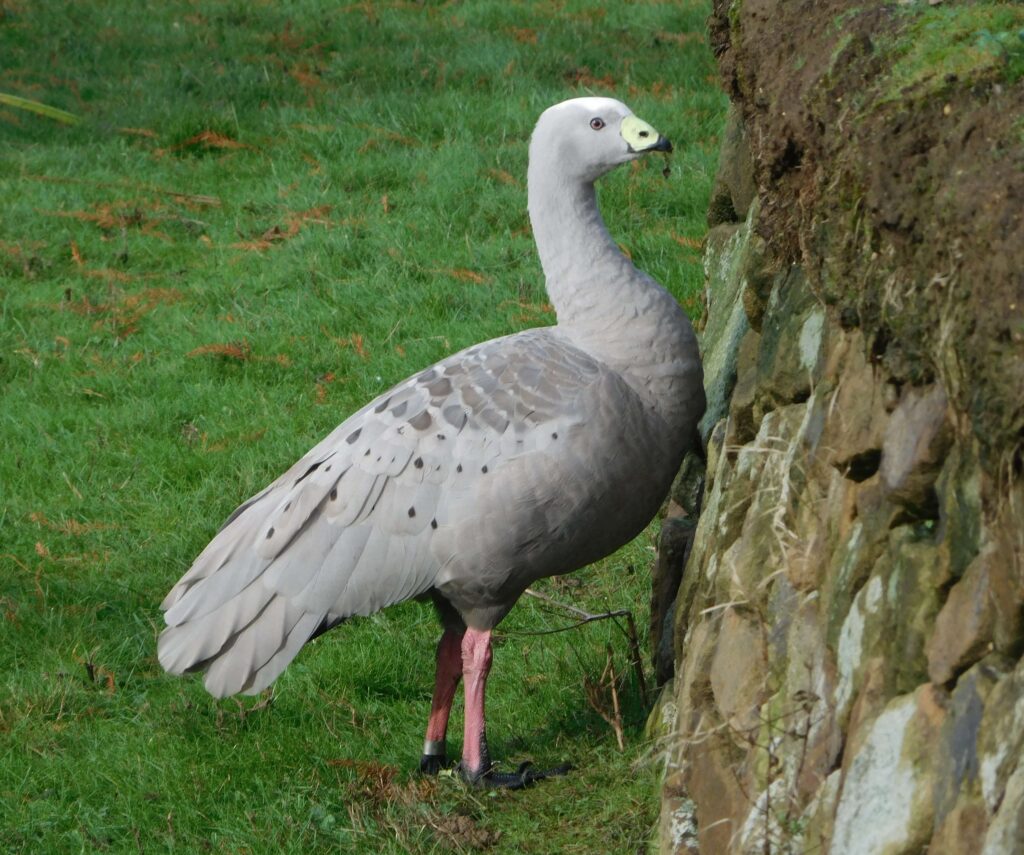
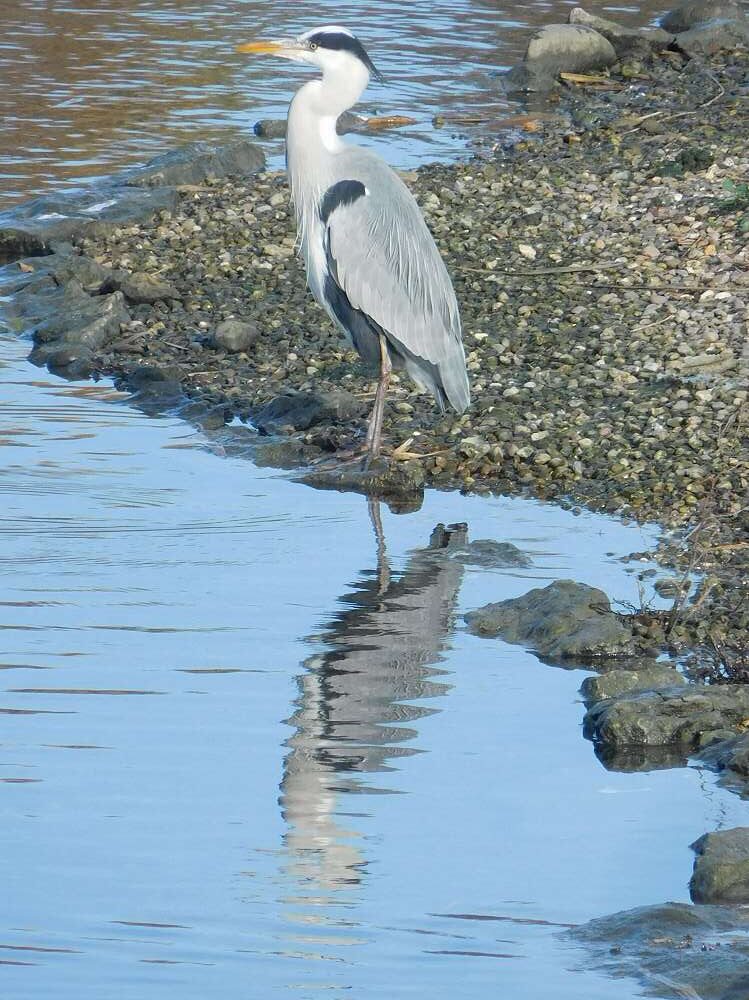
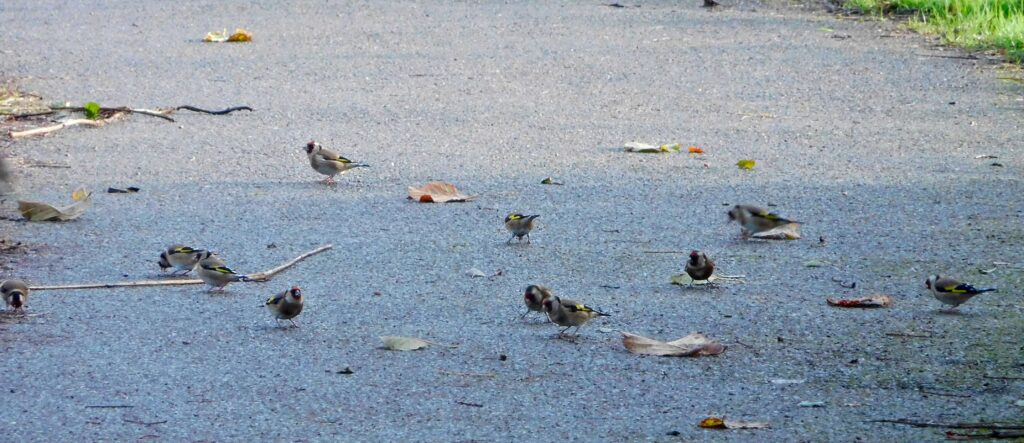
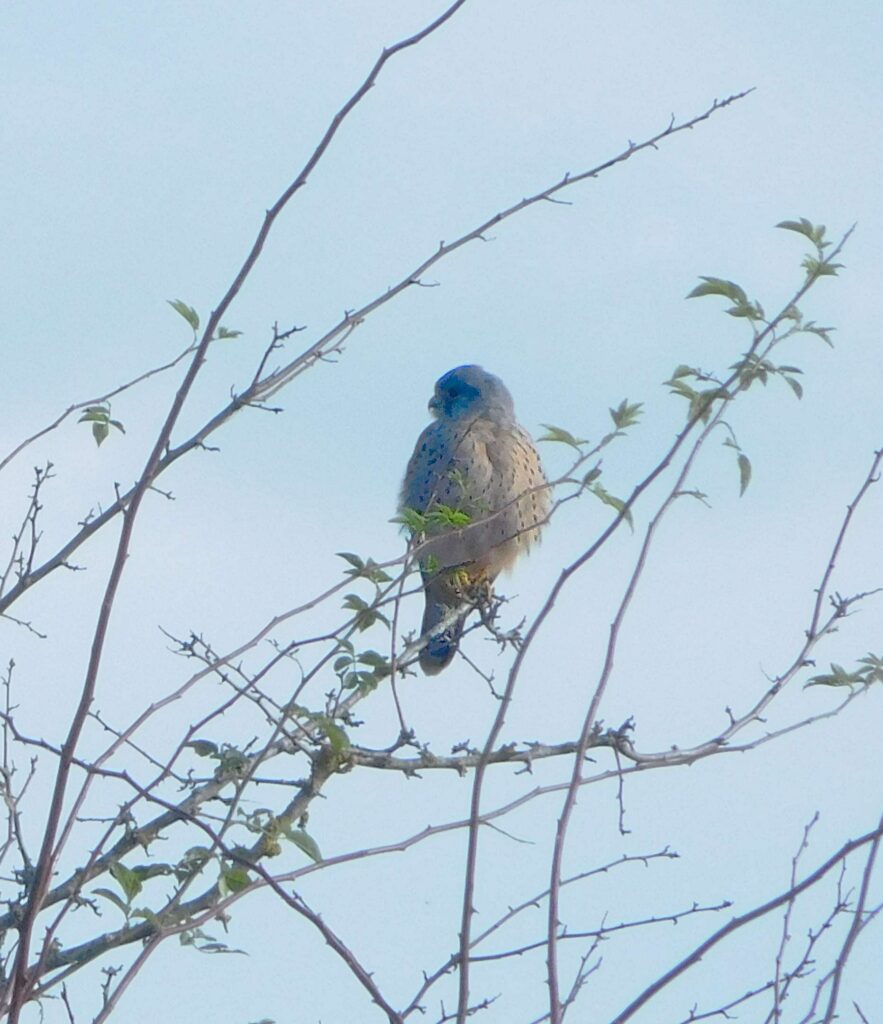
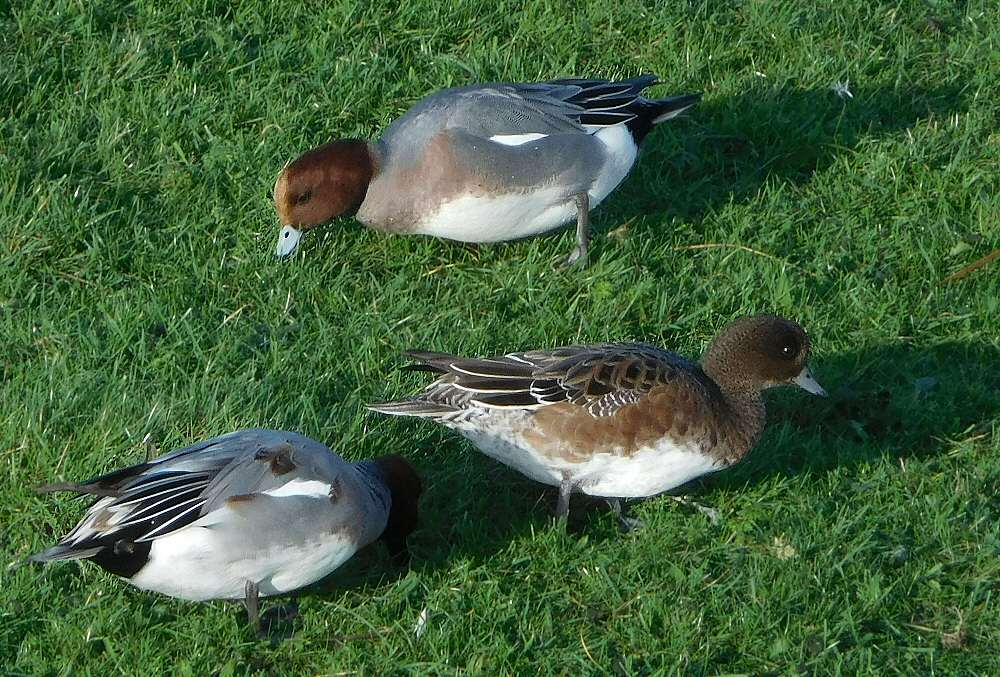






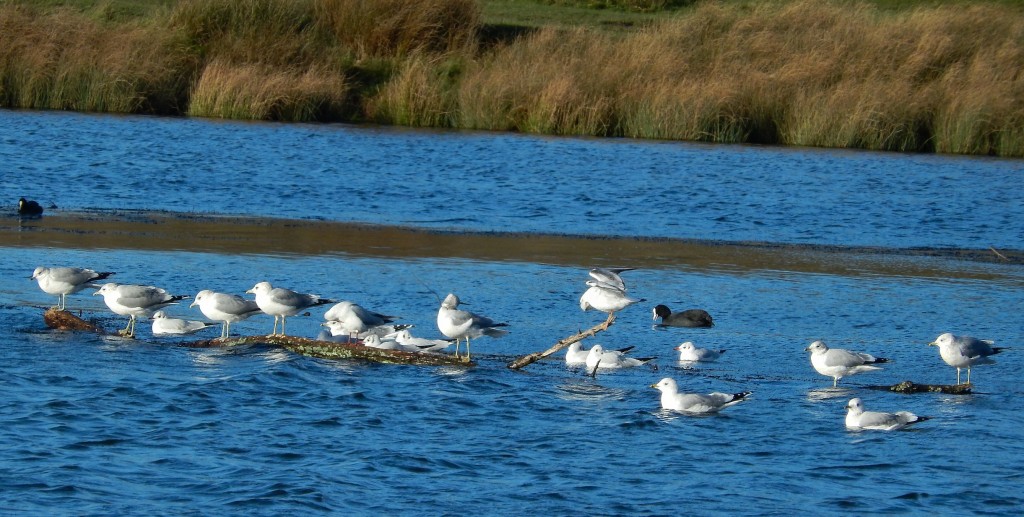
A fine cloudless day, with the jackdaws chasing about in the southwesterly breeze, the edge of Storm Eva that is blowing into the already flooded Northwest of Britain. A few winter ducks on the Pen Ponds – a Wigeon or two, a few dozen Gadwall – but the main surprise was the number of Common Gulls – at least thirty – in little flocks on both of the ponds. They can be seen here to have pale legs and ‘windows’ of white in their black wingtips, unlike the smaller Black-Headed gulls (there are one or two sitting in the water towards the left of the photo) which have very pale backs, no windows, and a black spot behind the eye (when they don’t have their chocolate-brown breeding hood, that is). Perhaps they have come down from the chilly North of Scandinavia to enjoy the very mild weather here.
A twittering, constantly moving flock of a dozen Goldfinches greeted my arrival at Wraysbury. The wind was already keen and I was glad of my thick fleece and waterproof jacket. A few Wood Pigeons and a Crow or two blew down the wind, hardly needing to flap. Even a Heron, doing its best to flap downwind as usual, rocketed past in the swift airstream. A solitary Fieldfare chattered to me from a bare thorn tree, its chack-chack unmistakable.
The stormy winds of the weekend had broken several large willows including the big one just North of the bridge: two branches had fallen, cracking off what are now revealed to be fragments of the hollow shell of the trunk. Willows and poplars are dangerous as the trunks are short-lived and often rotten inside: and the fast-growing branches can be very thick and heavy.
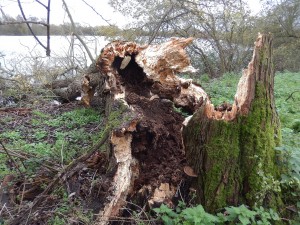
This tree by the lake snapped its seemingly solid, reassuringly mossy trunk and fell into the water. It was quite hollow, filled with soft brown beetle frass with finger-thick borings. Notice, however, the bracket fungus near the base.

The lake was covered in winter wildfowl, as the Channel at dawn on D-Day was covered with ships. I gave up trying to count the hundreds of Gadwall; there were dozens of Wigeon and Tufted Ducks, and plenty of Mute Swans, Canada Geese and Coots too. A few Cormorants, some with very white bellies, and a Great Crested Grebe or two made up the numbers. As I raised my binoculars, a Kingfisher darted from the near bank and raced right across the lake, perching on the far side.
The woods of Richmond Park were full of Jackdaws, constantly jostling for whatever position Jackdaws have in their noisy gangs. And the even noisier squawkings and screeches of the Ring-Necked Parakeets, of course, high in the trees or dashing about.
Out on the quieter grassland and bracken, now dry and brown, a Stonechat perched on a prominent lookout, its red breast, white collar and dark head distinctive.
A Kestrel drifted past, tail fanned, its handsome rufous back and dark wingtips characteristic; it turned and powered the other way, flew all across the open space over the anthilly grassland, and rose into a distant tree.
The upper Pen Pond had at least 6 Mandarin Ducks, the males ridiculously decorative, dressed like dandies and constantly showing off, alongside a few Pochard.
The lower Pen Pond had perhaps 30 Gadwall, a dozen Wigeon, a few Tufted Duck, and – best bird by far – a single Snipe that got up from the water’s edge near my feet, called ‘Creech’ once, and zigzagged rapidly off across the water, up and over the trees and the upper pond.
No wisecracks about Hips and Haws and keeping warm on chilly winter days! This morning it was actually more autumnal than wintery, with bright blue skies setting off the deeply red berries, the rosehips scarlet, the hawthorn berries crimson.
The birdlife however did give a hint of winter to come. The first half-dozen Redwings squawked softly and burst from the bushes in their peculiar way, twisting suddenly in flight to get out from between the branches, flapping noisily as they accelerate out of cover. A single big Mistle Thrush flew from higher up in a different tree.
A flock of Goldfinches, some Dunnocks, a Robin or two, a Blackbird, eight Magpies, a rapid Ring-Necked Parakeet, a Carrion Crow or two, and a few Black-Headed Gulls appeared here and there. A Sparrowhawk searched over the Poplar trees for unwary prey.
Down on the lake, too, the winter ducks are starting to arrive. There are good numbers of Gadwall (maybe 30) and Wigeon (50 or so) as well as Tufted (50) and Shoveler (100). A dozen Cormorants, a hundred Coots, a few Mallard, a couple of Mute Swans (where did they all go?), a few Canada Geese (ditto), and a solitary Great Crested Grebe made up the rest.
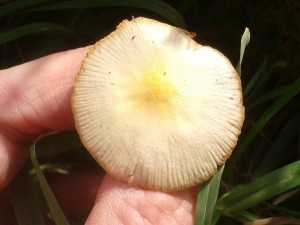
As a final treat, there was a slender, delicate stalk of the Yellow Inkcap, Coprinus auricomus, in the grass.
In Scotland, the male of the Red Deer is called simply a Stag, all other male deer (presumably Roe in that country) being known as Bucks. Down here, with Sika and other species about, it may be wise to name the species explicitly. There are signs up warning of the impending cull, so now may be the best time of year to see fine large stags resting quietly, the rut over.
I was welcomed to the park by a flock of Jackdaws chattering in the trees. Down in the valley, last year’s grass stalks are whitening, the fine big anthills well outlined in the low winter sunlight.
A Stonechat was perched on a slender stalk, level with the tops of the grass; there cannot be much in the way of insect food to catch just now.
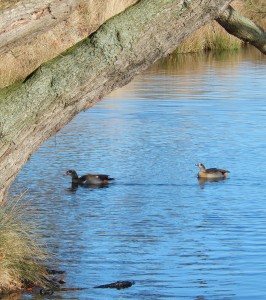
On the Pen Ponds, there were remarkably few waterfowl of any kind, but the lower pond had half-a-dozen Pochard. the males handsomely rufous-headed, a pair of Wigeon, the male with a conspicuous white wing-bar, and tucked in a corner under the willows a pair of Egyptian Geese, taking to the water and protesting with short dry honks when molested by a dog.
Walking back up the hill, a Kestrel hovered briefly, rested in a tree giving a good view of his spotted breast and back. Two herds of Red Deer, one at the base of the hill, one at the top, both with all ages and both sexes together, grazed silently. In the muddiest places, footprints of men, dogs and deer clustered together.
2 January may not seem like a good time for mushrooms, but even now there are interesting and beautiful species to be seen. The Variable Oysterling, Crepidotus variabilis, is as its name implies able to take on different appearances. Here its small cap is distinctly fluffy with tufts of hyphae. The gills are fairly widely spaced, and extra ones are inserted (ok, intercalated) towards the edges.

The Osiers – long thin whippy poles of willows ideal for basket-making – are seen at their most colourful in midwinter.
A flock of sixty or more grass-eating Wigeon, the males handsome with rufous heads complete with yellowish Mohican centre-stripe, grazed hungrily on the lush grass of the marsh. It must be a lot more welcoming than the frozen wastes of Scandinavia or Arctic Russia, where these birds have probably flown in from.